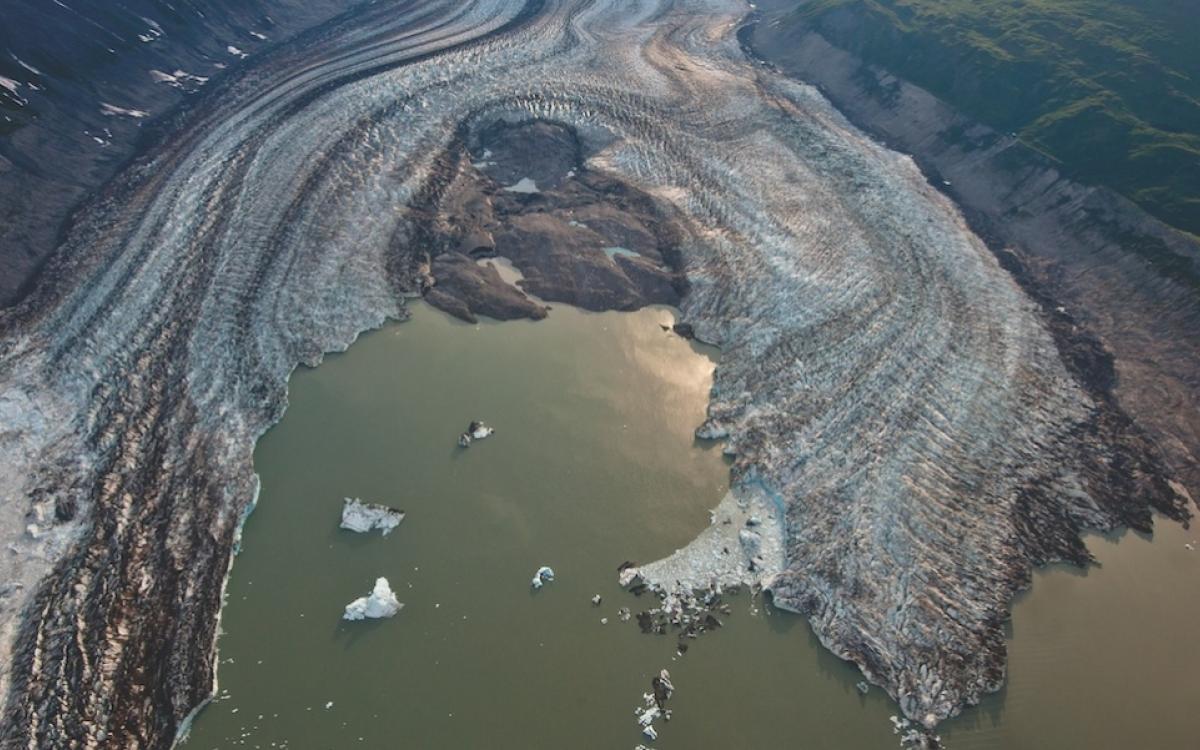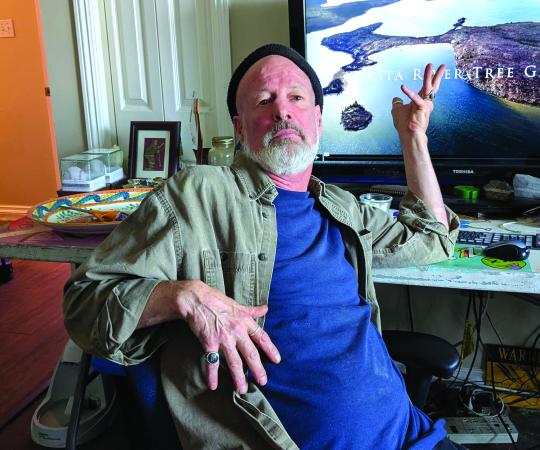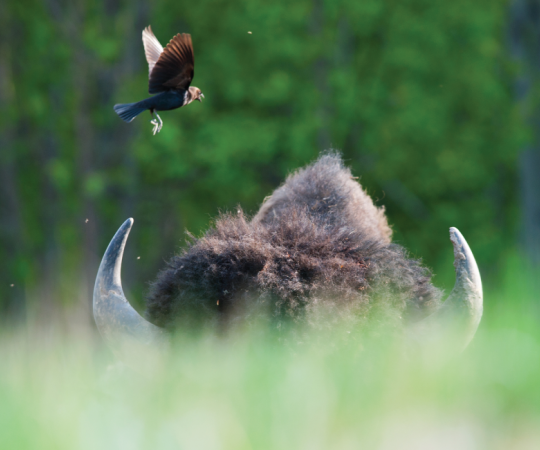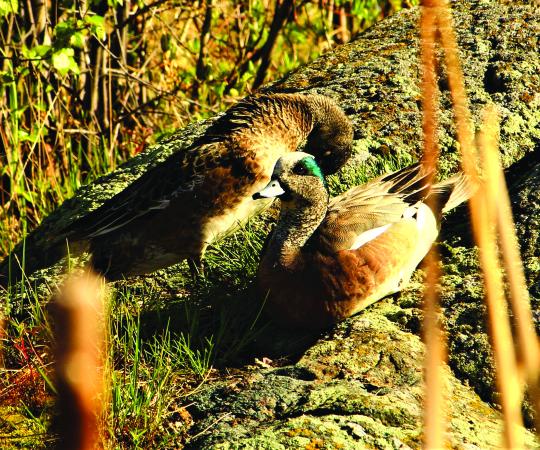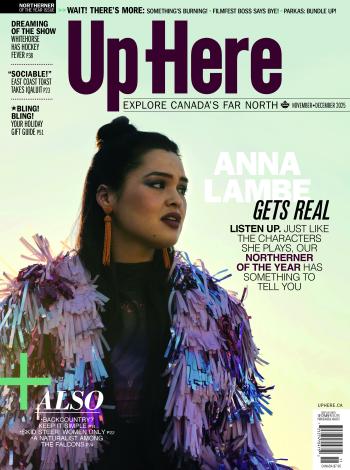Here, our waters are vital hunting grounds, the rivers are roads, and the skies brighten up after the sun goes down. Massive lakes can feel like oceans and dramatic mountain peaks and spires seem to disobey the laws of physics As you make your way north, the forest thins before your eyes to become tundra. This vast, rolling expanse—unjustly labelled the barren grounds—explodes with colour and life before it’s blanketed in white. These Northern lands leave you humbled. They challenge your expectations. They’re like nowhere else on the planet.

Graced with glaciers
The North is a frozen land. In a few pockets on Baffin Island, you can still visit remnants of the Laurentide Ice Shield, the massive layer of ice that covered much of the continent during the last Ice Age. With long winters and mountain ranges that span the west, far north and east of the three territories, Canada’s North has a striking array of glaciers to see: from the flying saucer-shaped piedmont glaciers on Bylot Island to Kluane’s valley glaciers (pictured above).
–Herb Mathisen

Discover the many ways Northern lakes are great
The North is home to lakes great in name and great in size.
While the Great Lakes basin in Southern Canada serves a population of 34 million, the Mackenzie River basin, which consists of both Great Slave (East Arm, pictured above) and Great Bear lakes, has a population of just 400,000—and 90 percent lives in Alberta. You could be on the water for days, even weeks, and not come across another person. Dipping in a paddle or hoisting your sails on either of these colossal bodies of freshwater in the NWT can feel more like an ocean adventure when all signs of land on the horizon disappear.
The North is also home to lakes of great importance. Délı̨nę, a community on Great Bear Lake, has a rich history and connection with these waters. Generations ago, the Prophet Aya, a revered local figure, spoke of the importance of protecting what he said would be one of the last freshwater oases left. His words have not gone unheeded.
And across the North, lakes have inspired some of our greatest homegrown tales. Robert Service made Lake Laberge, north of Whitehorse, the site of Sam Mcgee's cremation and resurrection. It wasn't by accident. These waterbodies are the perfect setting for any story—including your own. They teem with fish and they're so chilly and crystal-clear you can often drink directly from them. No matter how you experience the North's great lakes, they will leave a great impression. —Elaine Anselmi

Watch the forest slowly disappear
The Arctic treeline cuts a northwest course through the NWT (Coppermine River, pictured above) and into the northern reaches of the Yukon. But it’s not a literal boundary that no tree grows above. Ryan Danby, a Queen’s University ecologist, has made two recent paddle trips zigzagging across this line in the NWT. Think of it more as a transition zone with forest that gradually thins to tundra, he says. Still, that treeline is only a rough guide because it’s possible to stumble across a stand of trees when miles and miles of tundra surround you. How? Well, some microclimates can create micro-forests. At McKay Lake, 50 kilometres north of the treeline, Danby and his team came upon a boreal oasis—a small island with white spruce, red squirrels, and various fern species. All around it was tundra.
To see the vanishing forests with your own eyes, start at the B.C.-Yukon border and drive up the Alaska Highway to the Dempster and on to the Arctic Ocean. Dense lodgepole pine and white spruce meet stands of hardwood that give way to the alpine forests of Tombstone Territorial Park, and the treeless landscapes of Tuktoyaktuk. The change is dramatic—and you can witness it at your own pace. Or see it from the water like Danby. Some days he passed through tundra and then forest and back again. Since they never knew if they’d spend their nights camping among the trees, they needed to make a strategic call whenever they saw wood. “Maybe we should bring an extra log along.” —EA

Experience the highs of Northern skies
The rhythms of our Northern skies influence how we feel—the midnight sun’s lingering light is as restorative as the perpetual dark of polar nights is wearisome. We can’t escape the sky but we can embrace what it provides. The spectacle of a Northern sky inspires painters and poets and informs traditions.
Nowhere else in Canada can you get better views of the aurora borealis—the phenomenon created when collisions of solar particles in the Earth’s atmosphere send ribbons of colour rippling across the sky.
Aurora tourism has become big business, with companies across the North competing for local and international visitors hunting for the perfect view. Clear skies are key, so Aurora|360 is taking the chance out of aurora-viewing by offering a tour on a private charter flight in February that will carry passengers above the clouds.
“We want people to feel surrounded, to feel immersed in the aurora—on the flight, as well as from a scientific and cultural point of view,” says Kalin Pallet of Aurora|360. “The hope is that people feel connected to the cosmos, to something bigger than themselves.” On the ground or cruising the stratosphere, you’ll have no trouble feeling the power of the lights. —Jeremy Warren

See mountains as they are intended to be
The land North of 60 is home to some of the greatest and most stunning mountains on the continent. Mount Logan in the Yukon is our country’s tallest. Mount Thor (pictured above), on Baffin Island, is the world’s greatest vertical drop. (Yes, people do BASE jump it.) And then there’s that mystical cluster of peaks tucked deep in the nether regions of the Northwest Territories, known as Cirque of the Unclimbables, a veritable mecca for rock climbers the world over—and accessible only by helicopter or foot.
But there’s something else that makes the North’s great swaths of peaks stand out. Fly from Vancouver to Whitehorse on a clear, sunny day, and you’ll see lots of mountains from start-to-finish. As the shadow of your plane creeps northward along the spine of the Coastal mountains and crosses into the Yukon, the slopes are no longer shaved and sliced up with clear-cuts, resource roads or gas installations. The North’s mountains are barely scratched by development.
Look closely though and you’ll find human activity, alright: people hiking, backcountry skiing, climbing, mountain biking or flightseeing. These are mountains as mountains were made to be, teeming with caribou, peregrine falcons and, well, the odd person having the time of their life. —Katharine Sandiford

The south has roads. The North has rivers.
Hundreds of clean, free-flowing water routes drain this vast and (mostly) road-less land to the sea. Each has its own shimmering, snaking path, and there’s always something to discover around the river’s corner. A moose wades in the shallows, its enormous jaws dripping with water plants. A glacier feeds a waterfall into which you dip your face to take a drink. Thousands of caribou reshape a gravel bar in a splashy crossing. The perfect campsite beside an eddy swollen with grayling. Whatever it is, you keep telling yourself, “One more bend.”
Whether you’re travelling by canoe, raft or motorboat, river trips in the North can’t be beat. This is where you’ll find Canada’s most iconic rivers, after all. Even if you never get to travel down one, most Canadians are glad to know these wild rivers exist and can picture them vividly in their minds. The Coppermine conjures the image of a family of muskoxen grazing the riverside tundra grasses. The Nahanni shows us the jagged, misty cliffs of its Virginia Falls. The Yukon River brings us a scene of rafting fast past sweeping hoodoos and gold rush-era settlements. The Tatshenshini gives us glaciers calving into the silty water. The Horton has its eerie Smoking Hills. The Slave brings to mind some legendary whitewater kayaking.
The North is river country. More than any other geographical feature, this land is defined by its watersheds, veritable arteries coursing with life (unnamed river in Mackenzie Mountains, pictured above). —KS

The fireworks under your feet
When most people think of a Northern landscape, they’ll reflexively see tundra. And for good reason: it covers more than two million square kilometres of the Canadian Arctic, stretching north from the boreal forest into the archipelago.
The tundra has an incredibly short growing season, with only about 60 days each year where temperatures are warm enough for plants to grow. In winter, it can appear one endless horizon of white. But plants take full advantage of the summer’s midnight sun. By fall, the landscape explodes with life. “If you come at the last week of August, first week of September, the colours are magnificent,” says Mathieu Dumond, a photographer based in Kugluktuk, Nunavut. “It’s the fireworks of the tundra.”
The tundra presents a world of opportunity for photographers, says Dumond. Lie on your stomach and you’ll feel like you’ve entered a Lilliputian world, marveling at the textural and colour contrasts of the rock and lichen and berries and flowers. But then look up, and you’re presented with sweeping vistas, open to the sky, with not a tree in sight. —Jessica Davey-Quantick

Take a stroll on the sea
You warm up with tea, made of melt-water from the very platform you’re standing on. Suddenly, your colleagues cry out and you drop your mug and run to the floe edge. Right in front of you, just feet away, a narwhal comes up for a breath. It exhales and you gasp. Out on the ice, miles away from land, it’s all you hear.
Across the Arctic, the sea is many things. For most, it’s an ice highway—a road to resources that leads to hunting grounds, also on the ice. But it’s also a stable platform of the economy. Spring is a busy time and not just because it’s hunting season. Tour companies like Arctic Bay Adventures (based in Arctic Bay), Polar Outfitting (out of Iqaluit) or Black Feather (operating out of Pond Inlet) offer multi-day floe edge trips by snowmachine and qamutik. There, you go kayaking or dog-sledding, and camp out to see bird life, polar bears, and even the odd bowhead whale.
By mid-summer, Northern seas start to look like their southern counterparts, which briefly allows cruise ships to navigate the archipelago’s countless inlets and bays (off the coast of Baffin Island, north of Qikiqtarjuaq, pictured). But the ice is never far away. —HM

There’s nothing plain about them
The Taiga Plains stretch from Wood Buffalo National Park in the south to the Mackenzie River delta in the north, offering landscapes and wildlife you won’t see anywhere else in Canada.
The Mackenzie Delta’s diversity of islands, channels, swamps and lakes makes it one of the most productive and rich ecosystems for wildlife in the Canadian Arctic. Every year, a long list of migratory birds flocks to this marshy paradise where the Deh Cho flows into the Beaufort Sea. In the spring and summer, you’ll witness birds in breeding plumage and behaving in unique ways, says Bob Bromley, a retired ornithologist. “We get to see breeding behaviours—courtship rituals—that don’t take place on the wintering grounds very much,” he says. “The songs are often specific to the breeding season.”
At the southern end of the taiga plains, you’ll find Wood Buffalo National Park—Canada’s largest national park, where the eponymous wood bison roam and the endangered whooping crane nests. It’s also home to Canada’s only salt flats (pictured), a natural phenomenon usually found in deserts. Here, you can walk out of the boreal forest and step right onto barren, crusty plains so distinct and otherworldly they’ve been used for sci-fi film shoots.
The dry landscape of the salt flats is really more of a seascape—or rather remnants of an ancient sea. Saline groundwater is pushed to the surface, evaporates and leaves behind layers of salt on the cracked clay surface. Bison, bears and moose are fans of this giant, flat salt lick. (Yes, you can try the salt too.) In the summer, Parks Canada offers a weekly guided hike—“enjoy a barefoot pedicure strolling in the clay”—but feel free to wander on your own. —JW

And we even have a desert
From the sky, it looks like an industrial accident—like someone spilled a giant tanker of sand across two-and-a-half square kilometres of boreal forest, smothering the vegetation and awaiting remediation crews. This is the Carcross Desert: a sprawling, hilly field of dunes in the Yukon recognized as the world’s smallest desert. Bulldozed into place by receding glaciers roughly 15,000 years ago, the desert is maintained by steady winds blowing sands off nearby Bennett Lake.
Visiting the desert is a head-trip, like stumbling across an iceberg in the middle of the Sahara. Go there to have your reality shift, and your bearings challenged. Walk across the hot sand until you find a suitable shade-bush under which you can spread out your picnic blanket. Or just get scorched by desert heat while surrounded by snow-capped mountains.
Prefer a more participatory engagement with your landscape? Skydiving onto the desert is gaining popularity, the sand patch being an ideal soft-landing after your mind-blowing freefall above the mountains. Jumps are offered daily in July and August by SkydiveBC, who set up temporary shop in Carcross every summer. Extreme sport meets extreme beauty meets extreme desert. —KS

